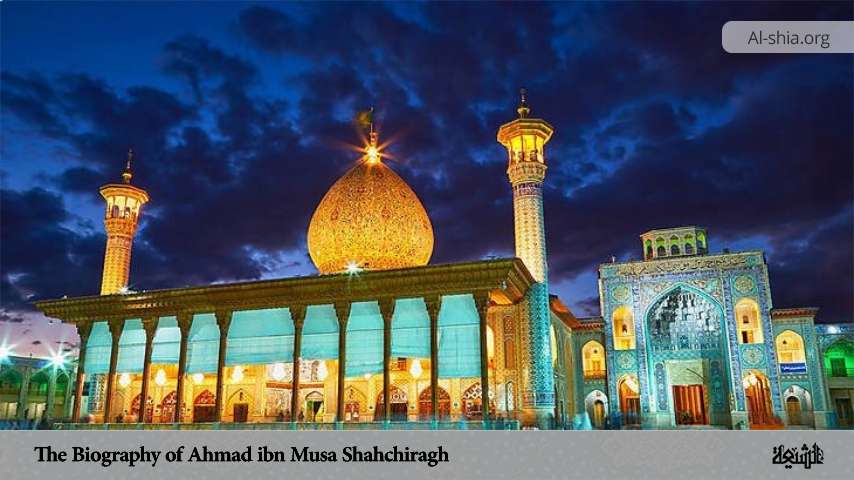mukhtar ibn Abi ʿUbayd al-Thaqafi was one of the Followers [Tabi’un] and the leader of one of the uprisings that took place after the tragedy of Ashura in revenge of the martyrdom of the grandson of the Holy Prophet, Imam Husain ibn Ali. During this uprising, many of those who participated in the killing of Imam al-Husain (peace be upon him) were killed. Mukhtar could not take part in the Battle of Karbala because he was imprisoned by ‘Ubaydullah ibn Ziyad when the battle was taking place.
His Lineage
Mukhtar is originally from the Thaqif clan of Ta’if[1]. His great grandfather was one of the noble personalities of Hijaz; Mas’ud al-Thaqafi[2] and his father, Abu ‘Ubayd al-Thaqafi, one of the noble companions of the Messenger of God[3] (peace be upon him and his household) who was killed in the Battle of al-Jisr [a.k.a. the Qadisiyya Wars] during the era of the second caliph[4].
His mother was Dawma, the daughter of ‘Amr ibn Wahb. Ibn Tayfur has reported that she spoke eloquently and was articulate[5]. His uncle, Sa’d ibn Mas’ud al-Thaqafi was appointed by the Commander of the Faithful, Ali ibn Abi Talib (peace be upon him) as the governor of Mada’in[6].
His Birth and Nickname
According to reports, Mukhtar was born in Ta’if in 622 CE[7] (the year the Prophet Muhammad migrated to Medina). His teknonym is Abu Ishaq[8], and was nicknamed Kaysan, which means smart and incisive. It is reported by Asbagh ibn Nubata that one day Imam ‘Ali (a) seated al-Mukhtar on his knees and addressed him by saying, “O Kayyis, O Kayyis[9],” and it was due to this that Mukhtar became famous as such.
His Youth
It is documented that Mukhtar at the age of 13 participated in the Battle of al-Jisr, where he lost his father and brothers. Regardless of his young age, he insisted on going to the battlefield but was prevented by his uncle, Sa’d ibn Mas’ud[10].
After the death of his father in November 634, Mukhtar, he remained in Iraq after the Muslim conquest of this region, and was raised by his uncle Sa’d ibn Masud al-Thaqafi. Thus, Mukhtar grew up in Kufa.
During the period of governorship of his uncle, Sa’d ibn Mas’ud al-Thaqafi at Mada’in, he appointed Mukhtar as his deputy when the former left to fight the Kharijites[11].
His Personality and Character
The first man to pay homage to Muslim ibn Aqil in Kufa was Mukhtar. He was one of the individuals who rushed to help Muslim ibn ‘Aqil on his arrival at Kufa[12]. It was even mentioned that Muslim ibn ‘Aqil stayed in Mukhtar’s house on his arrival at Kufa[13] but moved out to Hani ibn ‘Urwa’s house when ‘Ubaydullah ibn Ziyad found where he settled[14]. Historical reports show that Mukhtar intended to support Muslim ibn ‘Aqil, but Mukhtar had left Kufa for Khatarniyya, a place outside of Kufa, in an attempt to gather supporters on the day of his martyrdom[15]. Similarly, it is mentioned that Mukhtar used to fast most of the days in gratitude to his revenge from the murderers of Imam Husain (peace be upon him).
Given that the Thaqif tribe was known for their bravery. One of the attributes of Mukhtar is his bravery and his father and uncle were great military leaders of early Islam.
His Uprising
Mukhtar was imprisoned during the Battle of Karbala. After his release, he appeared in Kufa to avenge the murder of Imam al-Husain (peace be upon him). His mission was the same as that of the Tawwabun (the penitents) insofar as to revenge Husain’s blood, but differed in that, he intended to achieve political authority through a more organized military power.
According to the plans, the uprising was supposed to start on Thursday, Rabi’ Awwal 14, 66 (October 19, 685)[16], but with the early conflict between Ibrahim and Ayas ibn Mudarib, the commander of military forces in Kufa and the latter’s murder, the uprising started two days earlier on Tuesday Rabi’ A 12, 66 AH (October 17, 685). The Shi’a of Kufa supported him.
During his uprising, al-Mukhtar managed to kill Shimr ibn Dhi al-Jawshan, Khawli ibn Yazid, ‘Umar ibn Sa’d, and ‘Ubaydullah ibn Ziyad[17], and others who took part and played a significant role in the killing of Imam al-Husain (peace be upon him), his relatives and companions.
The commander of the army of the uprising was Ibrahim ibn Malik al-Ashtar (the son of Malik al-Ashtar al-Nakha’i), and he was the one who killed ‘Ubaydullah ibn Ziyad in Mosul[18].
It is pertinent to mention that Mukhtar used two phrases “Ya La-Tharat al-Husayn” [lit.: O the avengers of Husayn] and “Ya Manṣūr, Amit” [lit.: O the victor, kill] as his motto in order to encourage the Alawites to support him. When putting his war clothes on, Mukhtar informed his followers of the beginning of the uprising by chanting these mottoes[19].
Meanwhile, after eighteen months of rule and war with three groups, the Umayyads in Syria, the Zubayr Dynasty in Hijaz, and the nobles of Kufa, Mukhtar was finally killed by Mus’ab ibn Zubayr[20] on Ramadan 14, 67 AH (correspondent to April 3, 687) [21] at the age of 67 years. After Mukhtar’s death, his followers, consisting of 6000 people encircled in the palace, surrendered. Mus’ab ibn Zubayr ordered all of them to be killed[22].
Opinions about Mukhtar
In the opinion of the Ahl al-Bayt (peace be upon them), reports on Mukhtar can be categorized in two groups of approval and disapproval of Mukhtar, but Ayatollah Khoei trusts the reports that approve Mukhtar more. Similarly, in the opinion of Shi’a scholars, most Shi’a scholars believe Mukhtar was praised. Meanwhile, the opinions of some Shi’a scholars are as follow:
1. Mirza Muhammad al-Astarabadi:
For me, it is clear that we must not consider him to be bad, nonetheless, the narrations he quotes cannot be trusted either, and God knows him better than anyone else[23].
2. Al-Mamaqani:
This man (al-Mukhtar) followed the Imami sect and believed in the Imamate of the infallible Imams. He governed with the permission of Imam (peace be upon him), although his authenticity has not been proven. Yes, he has been blessed with praise and laud which has put him amongst righteous people. Even if there were no praise or virtue reported except for Imam al-Baqir’s (peace be upon him) prayer for him to be blessed, it would have been enough for him, especially that he repeated his prayer three times in one sentence[24].
3. Al-Allama al-Hilli:
He hasn’t mentioned any non-Imami persons in the first volume of his book, even if he were to be completely authentic and praised up to perfection, but he has mentioned al-Mukhtar in the first volume, which means that al-Allama al-Hilli considered him to be at least an Imami Shi’a[25].
4. Al-Allama al-Majlisi:
Al-Mukhtar was not complete in his faith and certitude, and did not have permission for the things he did, nevertheless, since he did many good deeds he died a faithful man. I am of those who have decided to remain silent regarding al-Mukhtar, although most scholars believe he was of the praised[26].
5. Sayyid ibn Tawus:
Even if we consider that the narrations against al-Mukhtar were not accusations (because al-Mukhtar and people like him were accused), we understand that narrations, which praise and thank al-Mukhtar are more preferable, since narrators differ about them, and for some reasons, it needs to be specially focused on[27].
6. Ayatollah Khoei:
Some reports suggest that al-Mukhtar’s uprising was with the special permission of Imam al-Sajjad (peace be upon him)[28].
References
[1] . Ibn Saʿd, al-Ṭabaqāt al-kubrā, vol. 2, p. 79.
[2] . Ibn Qutayba, al-Maʿārif, p. 14.
[3] . Ibn al-Athīr, Usd al-ghāba, vol. 4, p. 347.
[4] . Ibn Khaldūn, Tārīkh Ibn Khaldūn, Translation, vol. 1, p. 356.
[5] . Maḥallātī, Rayāḥīn al-sharī’a, vol. 4, p. 245.
[6] . Ibn Khaldūn, Tārīkh Ibn Khaldūn, Translation, vol. 1, p. 616.
[7] . Ibn al-Athīr, Usd al-ghāba, vol. 4, p. 347; Ibn al-Athīr, al-Kāmil fī l-tārīkh, vol. 2, p. 111.
[8] . Ibn al-Athīr, Usd al-ghāba, vol. 4, p. 346.
[9] . Khoei, Muʿjam rijāl, vol. 18, p. 102.
[10]. Majlisī, Biḥār al-anwār, vol. 45, p. 350.
[11] . Dīnawarī, al-Akhbār al-ṭiwāl, p. 250; Ibn Khaldūn, Tārīkh Ibn Khaldūn, Translation, vol. 1, p. 629.
[12] . Ibn al-Athīr, al-Kāmil fī l-tārīkh, vol. 4, p. 36.
[13] . Dīnawarī, al-Akhbār al-ṭiwāl, p. 231.
[14] . Dīnawarī, al-Akhbār al-ṭiwāl, p. 233; Masʿūdī, Murūj al-dhahab, vol. 3, p. 252.
[15] . Balādhurī, Ansāb al-ashrāf, vol. 6, p. 276; Ṭabarī, Tārīkh Ṭabarī, vol. 5, p. 569.
[16] . Ibn Miskawayh, Tajārib al-umam, vol. 2, p. 147.
[17] . Ibn al-Athīr, Usd al-ghāba, vol. 4, p. 347.
[18] . Ibn al-Athīr, Usd al-ghāba, vol. 4, p. 347.
[19] . Balādhurī, Ansāb al-ashrāf, vol. 6, p. 390; Ṭabarī, Tārīkh Ṭabarī, vol. 6, p. 20; Ibn Aʿtham al-Kūfī, Kitāb al-Futūḥ, vol. 6, p. 233.
[20] . Ibn al-Athīr, Usd al-ghāba, vol. 4, p. 347; Basawī, al-Maʿrifa wa al-tārīkh, vol. 3, p. 330.
[21] . Ibn al-Jawzī, al-Muntaẓam, vol. 6, p. 68.
[22] . Akhbār al-dawlat al-abbāsīya, p. 182.
[23] . Ardibīlī, Jāmiʿ al-ruwāt, vol. 2, p. 221.
[24] . Mamaqānī, Tanqīḥ al-maqāl, vol. 3, p. 206.
[25] . Mamaqānī, Tanqīḥ al-maqāl, vol. 3, p. 206.
[26] . Majlisī, Biḥār al-anwār, vol. 45, p. 339.
[27] . Mamaqānī, Tanqīḥ al-maqāl, vol. 3, p. 206.
[28] . Khoei, Muʿjam rijāl, vol. 18, p. 100.






